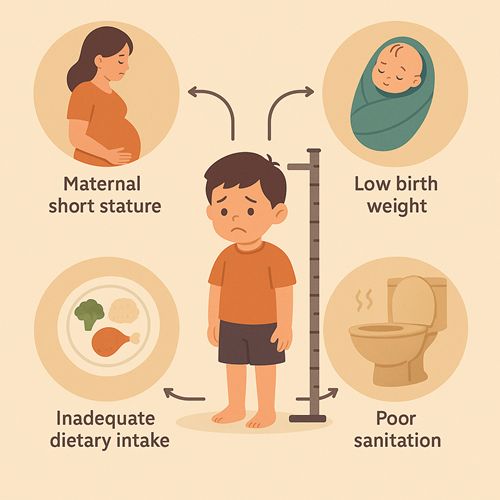Risk factors associated with stunting among toddlers aged 24–59 months: A Case-Control
Abstract
Introduction: Stunting remains a major public health concern in Indonesia, particularly in remote and highland regions such as the Bintang Mountains of Papua. It is characterized by impaired physical and cognitive development due to chronic malnutrition, repeated infections, and inadequate health services. Understanding the determinants of stunting in these settings is critical to inform effective interventions and policies.
Methods: This study employed an analytical survey with a case-control design to examine risk factors associated with stunting among toddlers aged 24–59 months in the Oksibil Health Center working area, Bintang Mountains Regency, Papua. A total of 66 respondents were recruited between April and May 2024, consisting of 33 stunted toddlers (cases) and 33 non-stunted toddlers (controls). Data were collected through structured interviews and analyzed using odds ratios (ORs) with 95% confidence intervals to identify significant risk factors.
Results: The findings revealed that several factors were significantly associated with stunting: maternal knowledge (OR = 1.911), history of infectious diseases (OR = 8.090), environmental sanitation (OR = 1.375), socio-cultural practices (OR = 3.801), and health service utilization (OR = 9.339). Among these, inadequate health service utilization posed the highest risk. Socio-cultural norms, poor hygiene practices, and limited maternal awareness were also strongly linked to stunting prevalence.
Conclusion: Stunting in the Bintang Mountains is strongly influenced by a combination of health service gaps, infectious diseases, socio-cultural factors, and insufficient maternal knowledge. Strengthening maternal Education, improving sanitation, addressing harmful cultural practices, and expanding access to health services are critical strategies to reduce stunting prevalence in highland and resource-limited areas of Indonesia
Downloads
References
Alam, M. B. et al. (2024) ‘Effects of disability on adverse health outcomes and anthropometric deficits among under-five children in South Asian countries: evidence from multiple indicator cluster surveys’, The Lancet Regional Health - Southeast Asia, 25, p. 100401. doi: https://doi.org/10.1016/j.lansea.2024.100401.
Amegbor, P. M. et al. (2025) ‘Exploring the effect of early-life climate anomalies on child growth in Sub-Saharan African context: Insight from the demographic & health survey’, Science of The Total Environment, 983, p. 179658. doi: https://doi.org/10.1016/j.scitotenv.2025.179658.
Arda, D., Lalla, N. N. L. N. and Suprapto, S. (2023) ‘Analysis of the Effect of Malnutrition Status on Toddlers’, Jurnal Ilmiah Kesehatan Sandi Husada, 12(1), pp. 111–116. doi: https://dx.doi.org/10.35816/jiskh.v12i1.910.
Ashar, H. et al. (2025) ‘A qualitative study in Magelang Central Java Indonesia: Mothers’ knowledge, parenting styles and national priority programs managing of stunting in toddlers’, Social Sciences & Humanities Open, 12, p. 101874. doi: https://doi.org/10.1016/j.ssaho.2025.101874.
Ataullahjan, A. et al. (2025) ‘Social sector drivers and stunting reduction in Pakistan: A subnational analysis’, The American Journal of Clinical Nutrition, 121, pp. S78–S85. doi: https://doi.org/10.1016/j.ajcnut.2024.09.025.
Ayu Rahmadani, R. et al. (2025) ‘Effectiveness of nutrition education on stunting prevention behavior in mothers under five’, Jurnal Edukasi Ilmiah Kesehatan, 3(1), pp. 01–08. doi: https://doi.org/10.61099/junedik.v3i1.68.
Balza, L. H. et al. (2025) ‘Infrastructure Services and Early Childhood Development in Latin America and the Caribbean: Water, Sanitation, and Garbage Collection’, World Development, 185, p. 106817. doi: https://doi.org/10.1016/j.worlddev.2024.106817.
Bhutta, Z. A. et al. (2025) ‘What works for reducing stunting in low-income and middle-income countries? Cumulative learnings from the Global Stunting Exemplars Project’, The American Journal of Clinical Nutrition, 121, pp. S113–S128. doi: https://doi.org/10.1016/j.ajcnut.2025.03.004.
Garina, L. A. et al. (2024) ‘Maternal, Child, and Household Risk Factors for Children with Stunting’, The Open Public Health Journal, 17(1). doi: https://doi.org/10.2174/0118749445321448240823112908.
Gayawan, E. and Egbon, O. A. (2023) ‘Spatio-temporal mapping of stunting and wasting in Nigerian children: A bivariate mixture modeling’, Spatial Statistics, 58, p. 100785. doi: https://doi.org/10.1016/j.spasta.2023.100785.
Godoy, R. et al. (2024) ‘Adult knowledge of wild plants associated with limited delayed health and nutritional benefits for children or adults in the face of external change: A yearly panel (2003−2010) study among Tsimane’, an indigenous Amazonian society in Bolivia’, Evolution and Human Behavior, 45(5), p. 106594. doi: https://doi.org/10.1016/j.evolhumbehav.2024.106594.
Htay, Z. W. et al. (2023) ‘Factors associated with syndemic anemia and stunting among children in Myanmar: A cross-sectional study from a positive deviance approach’, Archives de Pédiatrie, 30(6), pp. 372–377. doi: https://doi.org/10.1016/j.arcped.2023.03.010.
Islam, M. et al. (2025) ‘Drivers of stunting and wasting across serial cross-sectional household surveys of children under 2 years of age in Pakistan: potential contribution of ecological factors’, The American Journal of Clinical Nutrition, 121(3), pp. 610–619. doi: https://doi.org/10.1016/j.ajcnut.2025.01.003.
Jalloh, U. H. et al. (2025) ‘A mixed-methods study of the drivers of stunting reduction among children under-5 in Sierra Leone, 2005–2017’, The American Journal of Clinical Nutrition, 121, pp. S106–S112. doi: https://doi.org/10.1016/j.ajcnut.2025.02.015.
Jokhu, L. A. and Syauqy, A. (2024) ‘Determinants of concurrent wasting and stunting among children 6 to 23 mo in Indonesia’, Nutrition, 122, p. 112390. doi: https://doi.org/10.1016/j.nut.2024.112390.
Koomson, I., Afoakwah, C. and Twumasi, M. A. (2024) ‘Racial diversity, child stunting and underweight: Policies design and promotion in South Africa’, Journal of Policy Modeling, 46(6), pp. 1243–1262. doi: https://doi.org/10.1016/j.jpolmod.2024.05.009.
Landin Basterra, E. et al. (2025) ‘Impact of social protection on child malnutrition and mortality across 46 LMICs: a longitudinal study over two decades with insights from the COVID-19 pandemic’, eClinicalMedicine, 87, p. 103414. doi: https://doi.org/10.1016/j.eclinm.2025.103414.
Li, J. (2024) ‘Less stunted? The impact of Chinese health aid on child nutrition’, Social Science & Medicine, 342, p. 116559. doi: https://doi.org/10.1016/j.socscimed.2024.116559.
Mgomezulu, W. R. et al. (2025) ‘Advancing predictive analytics in child malnutrition: Machine, ensemble and deep learning models with balanced class distribution for early detection of stunting and wasting’, Human Nutrition & Metabolism, 42, p. 200340. doi: https://doi.org/10.1016/j.hnm.2025.200340.
Mulatu, S. et al. (2025) ‘A high prevalence of stunting was observed among under-five children: A community-based cross-sectional study’, Clinical Nutrition ESPEN, 66, pp. 343–351. doi: https://doi.org/10.1016/j.clnesp.2025.01.060.
Ndovie, P. et al. (2025) ‘Exploring the determinants of undernutrition among children aged 6-59 months old in Malawi: Insights on religious affiliation, ethnicity, and nutritional status using the 2015-2016 Malawi demographic and health survey’, Nutrition, p. 112922. doi: https://doi.org/10.1016/j.nut.2025.112922.
Otoo, G. E. et al. (2025) ‘A mixed-methods study of the drivers of stunting reduction among children under-5 in Ghana, 2003–2017’, The American Journal of Clinical Nutrition, 121, pp. S95–S105. doi: https://doi.org/10.1016/j.ajcnut.2025.02.011.
Oyenubi, A. and Rossouw, L. (2024) ‘Is the impact of the South African child support grant on childhood stunting robust? An instrumental variable evaluation’, Children and Youth Services Review, 164, p. 107829. doi: https://doi.org/10.1016/j.childyouth.2024.107829.
Putri, S. Z., Bachtiar, S. M. and Suprapto, S. (2025) ‘A Descriptive Case Series on Combined Education, Breast Care, and Oxytocin Massage for Lactation Support in Indonesia’, Journal of Public Health Sciences, 4(02), pp. 165–179. doi: https://doi.org/10.56741/IISTR.jphs.001030.
Safitri, M. et al. (2025) ‘Stunting and blood lead levels in a non-industrial rural area: the role of microminerals in child growth risk assessment’, Pharmacia, 72, pp. 1–8. doi: https://doi.org/10.3897/pharmacia.72.e161066.
Supadmi, S. et al. (2024) ‘Factor related to stunting of children under two years with working mothers in Indonesia’, Clinical Epidemiology and Global Health, 26, p. 101538. doi: https://doi.org/10.1016/j.cegh.2024.101538.
Suprapto, S. (2022) ‘Pengaruh Edukasi Media Kartun Terhadap Peningkatan Pengetahuan Ibu dan Status Gizi Anak’, Journal of Health (JoH), 9(2), pp. 81–87. doi: https://doi.org/10.30590/joh.v9n2.500.
Suprapto, S. et al. (2025) ‘How is Quality in Homecare Services Created? A Qualitative Study of Health Professional Perspectives’, Jurnal Kesehatan Masyarakat, 21(2), pp. 485–496. doi: https://doi.org/10.15294/kemas.v21i2.31257.
Tyarini, I. A. et al. (2024) ‘Health education lecture method to increase posyandu cadres’ knowledge about stunting prevention in children’, Jurnal Ilmiah Kesehatan Sandi Husada, 13(1), pp. 62–68. doi: https://doi.org/10.35816/jiskh.v13i1.1173.
Wand, H. et al. (2024) ‘Geospatial correlations and variations in child mortality and stunting in South Africa: Evaluating distal vs structural determinants’, Spatial and Spatio-temporal Epidemiology, 50, p. 100653. doi: https://doi.org/10.1016/j.sste.2024.100653.

Copyright (c) 2025 Kumbendy Sada, Zakaria Zakaria, Muhammad Rifai

This work is licensed under a Creative Commons Attribution 4.0 International License.




2.png)
1.png)
1.png)










